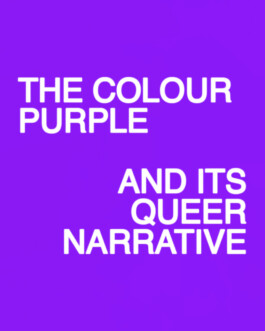
Purple, the color of royalty and opulence, evokes feelings of trust, and reliability, and taps into the realm of creativity and fantasy. But what connection does it have with QUEERNESS?
by Clemens Egger (he/him), 20 August 2023
The shade of purple, particularly in its lavender and violet nuances, holds a distinctive and impactful place in the narrative of QUEERNESS. Spanning from ancient Greece to the modern LGBTQIA+ community, these shades have been intertwined with expressions of desire, love, activism, and defiance. Let's embark on an exploration of the intricate significance of the color purple within the contexts of lesbian and queer history, literature, art, and fashion.
The origins of this association can be traced back to ancient Greece and the poet SAPPHO from the island of Lesbos. Through her verses, SAPPHO described her amorous affections for younger women adorned with "violet tiaras," often referring to them as "purple blooms." These violets later evolved into symbols of women loving women in the 1920s, with the gifting of purple flowers becoming an expression of "sapphic interest." The term "Sapphic" persists as an encompassing label for lesbians, bisexual/pansexual women, and queer women, even serving as a synonym for "WLW" (Women Loving Women).
With the accidental discovery of purple synthetic dye, the color gained popularity in 19th-century fashion. Everyday men boldly sported lavender trousers and purple shirts paired with blue waistcoats, all without raising an eyebrow. However, as the 19th century neared its end, lavender and purple became linked with homosexuality, a connection amplified by the emergence of Aestheticism—an art movement in Europe valuing aesthetics over industrial functionality. This period saw the re-examination of purple's significance in SAPPHO's writings by one of the prominent aesthetes, OSCAR WILDE, who employed the color to portray love between men in 1900. He poetically described his "purple hours" spent with other men, or more explicitly, rent boys:
"In the mortal sphere I have fallen in and out of love, and fluttered hawks and doves alike. How evil it is to buy love, and how evil to sell it! And yet, purple hours one can snatch from that gray, slowly-moving thing we call Time! My mouth is twisted with kissing, and I feed on fevers."
Aside from SAPPHO and WILDE, purple, serving as a symbol of joy and subversion, continued to appear in literature, resurfacing in the German cabaret song "Das Lila Lied" (The Lavender Song) during Berlin's queer-inclusive 1920s. This song became a resonant anthem of pride for the queer community, channeling a powerful message of resistance:
“What makes them think they have the right to say what God considers vice
What makes them think they have the right to keep us out of Paradise
They make our lives hell here on Earth
poisoning us with guilt and shame
If we resist, prison awaits so our love dares not speak its name
The crime is when love must hide
From now on we'll love with pride
CHORUS:
We're not afraid to be queer and different
if that means hell -- well, hell we'll take the chance
they're all so straight, uptight, upright and rigid
they march in lockstep we prefer to dance
We see a world of romance and of pleasure
All they can see is sheer banality
Lavender nights are our greatest treasure
where we can be just who we want to be
Round us all up, send us away
that's what you'd really like to do
But we're too strong, proud, unafraid
in fact we almost pity you
You act from fear, why should that be
What is it that you are frightened of
The way that we dress
The way that we meet
The fact that you cannot destroy our love
We're going to win our rights
to lavender days and nights“
While Berlin's queer community seemed to thrive, the 1930s cast a shadow over America's LGBTQIA+ community. The term “lavender” was cruelly lexicalized and gay men were ridiculed, taunted, and mocked for having a “streak of lavender”. That phrase is based on the biography of none other than ABRAHAM LINCOLN, which was published in 1926 by biographer Carl Sandburg. He wrote that the president had male friendships that contained a “streak of lavender, and spots soft as May violets,” suggesting that Lincoln had homosexual tendencies or, in today's language, was actually bisexual.
Discrimination escalated, notably during the "Lavender Scare" of the mid-20th century, where LGBTQIA+ individuals were considered security risks, leading to their persecution and expulsion from government jobs. Thousands of gay employees were fired or forced to resign from the federal workforce because of their sexuality. This wave of repression was bound up with anti-Communism, also referred to as “The Red Scare”, a congressional witch-hunt against Communists during the early years of the Cold War.
Another pivotal moment in queer history is the rise of the "Lavender Menace"—an informal group of radical lesbian feminists. They united in protest against the exclusion of lesbians from the broader feminist movement, aiming to reclaim and address their visibility. Their actions marked a turning point in the second wave of feminism, as well as the birth of the lesbian-feminist movement, with the formation of the "Radicalesbians." At a national conference in September 1971, delegates passed a resolution calling lesbians in the movement and lesbian rights "a legitimate concern for feminism.”
In summation, the intricate link between the color purple and QUEERNESS encompasses a journey through history, literature, activism, and identity. From SAPPHO's verses to OSCAR WILDE’s prose, from German cabarets to American struggles, purple embodies both the adversities faced by the LGBTQ+ community and their relentless pursuit of visibility, acceptance, and pride. Within the tapestry of history, the color purple remains an unwavering thread, woven with the streak of lavender signifying oppression, alongside the vibrant hues of resistance and pride defining the journey of the queer community.
Sources:
https://dressingdykes.com/2021/08/20/from-lavender-to-violet/
https://edition.cnn.com/style/article/lgbtq-lavender-symbolism-pride/index.html
https://time.com/5922679/lavender-scare-history/
https://www.archives.gov/publications/prologue/2016/summer/lavender.html
https://historynewsnetwork.org/article/175872
https://www.thoughtco.com/lavender-menace-feminism-definition-3528970